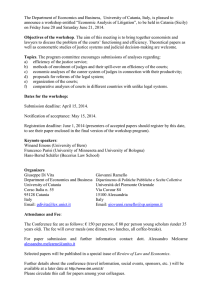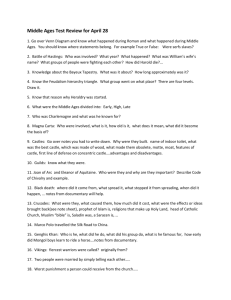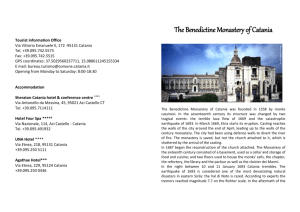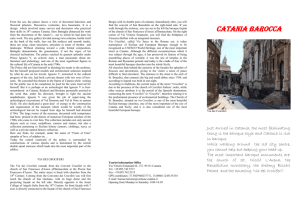The Castle of Aci Castello - IIS Ramacca
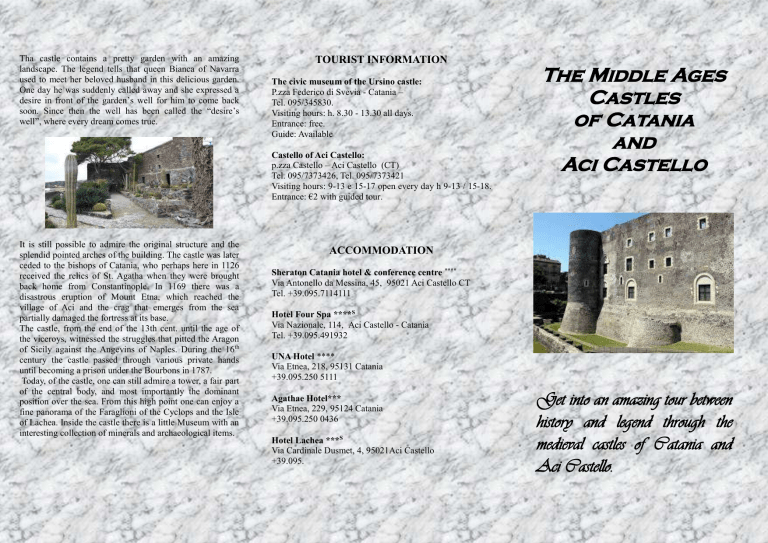
Tha castle contains a pretty garden with an amazing landscape. The legend tells that queen Bianca of Navarra used to meet her beloved husband in this delicious garden.
One day he was suddenly called away and she expressed a desire in front of the garden’s well for him to come back soon. Since then the well has been called the “desire’s well”, where every dream comes true.
It is still possible to admire the original structure and the splendid pointed arches of the building. The castle was later ceded to the bishops of Catania, who perhaps here in 1126 received the relics of St. Agatha when they were brought back home from Constantinople. In 1169 there was a disastrous eruption of Mount Etna, which reached the village of Aci and the crag that emerges from the sea partially damaged the fortress at its base.
The castle, from the end of the 13th cent. until the age of the viceroys, witnessed the struggles that pitted the Aragon of Sicily against the Angevins of Naples. During the 16 th century the castle passed through various private hands until becoming a prison under the Bourbons in 1787.
Today, of the castle, one can still admire a tower, a fair part of the central body, and most importantly the dominant position over the sea. From this high point one can enjoy a fine panorama of the Faraglioni of the Cyclops and the Isle of Lachea. Inside the castle there is a little Museum with an interesting collection of minerals and archaeological items.
TOURIST INFORMATION
The civic museum of the Ursino castle:
P.zza Federico di Svevia - Catania –
Tel. 095/345830.
Visiting hours: h. 8.30 - 13.30 all days.
Entrance: free.
Guide: Available
Castello of Aci Castello: p.zza Castello – Aci Castello (CT)
Tel. 095/7373426, Tel. 095/7373421
Visiting hours: 9-13 e 15-17 open every day h 9-13 / 15-18.
Entrance: €2 with guided tour.
ACCOMMODATION
Sheraton Catania hotel & conference centre ****
Via Antonello da Messina, 45, 95021 Aci Castello CT
Tel. +39.095.7114111
Hotel Four Spa **** S
Via Nazionale, 114, Aci Castello - Catania
Tel. +39.095.491932
UNA Hotel ****
Via Etnea, 218, 95131 Catania
+39.095.250 5111
Agathae Hotel***
Via Etnea, 229, 95124 Catania
+39.095.250 0436
Hotel Lachea *** S
Via Cardinale Dusmet, 4, 95021Aci Castello
+39.095.
The Middle Ages
Castles of Catania and
Aci Castello
Get into an amazing tour between history and legend through the medieval castles of Catania and
Aci Castello.
The Normans in Sicily
After the Norman conquest of Sicily, it became very important to have some fortresses in strategic areas of the region in order to control the territory and avoid foreign attacks.
As usual, the Normans exploited some ancient rocks facing the sea or the plain land and coming from millenary eruptions. This is the case of all Norman castles in the city and the province of Catania.
Ursino Castle
During the first half of the 13 th century under Frederick
II, Ursino Castle, initially called ''Castrum Sinus'', was a masterly amalgamation of Eastern and Western design symbolically and geometrically.
This building was originally on a promontory overlooking the sea for maximum security and defence. Constructed of a large inner square with four large outer round towers, it was considered an excellent architectural success, also during the
Aragon's dynasty.
Its distance from the sea now is due to an earthquake in 1600, and to some Etna eruptions. Lava flowing right up to the castle, buried a part of it, filling the moat, covering and enlarging the coastline. The castle was also the scene of political change when Frederick
III was proclaimed king.
It became a prison for a short while in the 19 th century, before being transformed into a museum, and venue for art exhibitions.
The Civic Museum of Catania is placed inside the castle.
It preserves some of the best evidences of the history of this town and of its artistic production.
These are finds coming from the collections of the
Benedictine monks, the baron Zappalà-Asmundo, and the prince of Biscari. Among the exhibited works, the most interesting is the “ Madonna ed il bambino” by
Antonello De Saliba (1466-1535). This work signed and dated back to 1497, was part of a polyptych, which was kept in in the church of Santa Maria del Gesù. The painting sant'Onofrio, by Bernazzo, who was a member of Cesare da Sesto's group, dates back to 1536. San
Giacomo, an oil painting, was made by Bernardino
Niger, who lived in the second half of the sixteenth century.
Among the other works there are: the Madonna col bambino, by Lorenzo di Credi's studio (1456-1537);
L'Ultima Cena, by the Spanish Luis de Morales; other masterpieces belong to private seventeenth and eighteenth century collections; a big painting,
Melanconia, is by Domenico Fetti's Group, (1589-
1624). This work is a particularly attracting copy of the original, belonging to the Academy Galleries of Venice, where a young woman is represented kneeling and holding a skull, meditating upon frailty of human events.
The Museum also keeps some works by some nineteenth century painters from Catania; among these we find: Testa di Ofelia pazza, painted by Michele
Rapisardi; Ritratto di famiglia, by Giuseppe Rapisardi and Paesaggio con l'Etna, by Giuseppe Sciuti, one of the best painter in Catania of the nineteenth century.
On the ground floor, in the thirteenth century hall, some
Greek and Roman sculptures are kept. Most of them come from the Grecian-Roman theatre and from the
Roman amphitheatre and have been donated to the museum by the Prince of Biscari.
In the Tower of the Martyrs, Aphrodite, which was recomposed with its original parts, is kept. Moreover, the museum includes, also, a collection of Attic and
Corinthian vases, numismatic collections, old prints and bizarre eighteenth-century objects, such as cribs.
The Castle of Aci Castello
Travelling north along the coastline of Catania, you will find Aci Castello, a fishers’ village on the sea not far from
Catania.
The Norman fortress of the city built of black lava stands on top of a spur of rock high above the blue sea. Owing to its strategic importance, it has been a fortified strong post since Roman times, when this was the site of the Rocca
Saturnia. It was conquered by Roger de Hauteville and his
Normans in 1072 after his victory over the Arabs.
Destroyed several times, it was rebuilt by King Tancredi in
1189.

